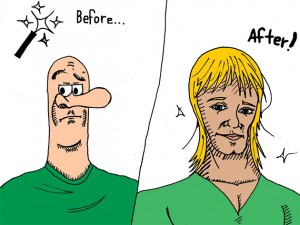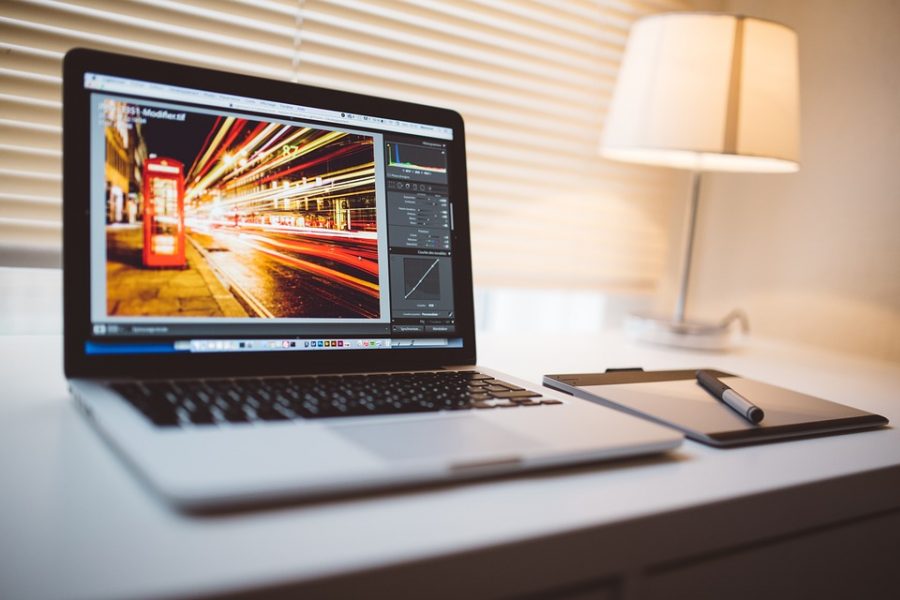The Negative Impacts of Photoshop
October 1, 2013
In today’s world, the excessive use of Photoshop can be found in the majority of the photos we see.
From advertisements to magazines, we are endlessly surrounded by unrealistic images. In a society that promotes a flawless physique and features as the “norm,” young girls and women often feel the pressure to conform to the unrealistic expectations promoted through digitally altered photos.
Not only does excessive use of Photoshop on photos send out a poor message, but it also can cause low self-esteem and body image issues.
Instead of being used to enhance the quality of photos, Photoshop is used to completely distort a woman’s body into something it’s not.
Models that are already scarily skinny are made even smaller by magazines and photographers. Their waists are shrunk, their arms and legs become nothing but bones and every imperfection is completely erased.
Some photos go as far as to morph the women into figures that are impossible to achieve in reality and are nothing short of Barbie-like.
The negative message these photos send out, especially to someone who is already struggling with their image, is awful.

Not only does excessive use of Photoshop on photos send out a poor message, but it also can cause low self-esteem and body image issues.
These types of photos lead us to believe that beauty can only exist in an unachievable body type; that it’s even remotely healthy to look like the models in the photos we see. It teaches us that it’s appropriate to try to hide our flaws at all costs instead of embracing them.
Hours spent at the gym and extreme dieting can’t even create the image that Photoshopped pictures do. Yet young women and girls are led to believe it can be because of what they see on the covers of magazines day after day.
Instead of focusing on what is healthy and all different types of body shapes, we are presented with the same Barbie-like figure time and time again.
These are not safe or healthy ideals to be sending out to an impressionable audience.
A good portion of the problem comes from the influence of the entertainment industry.
In society, celebrities often define what culture believes is beautiful, and almost all of the images we see of celebrities and models in magazines are edited to some extent.
We tend to praise these highly edited images instead of seeing them for what they really are, which is fake.
No one can have perfect skin, a size 0 body and flawless features, though we fool ourselves into thinking that it’s achievable. When young girls see their role model on the cover of a magazine conforming to these images, they think they have to as well.
These ridiculous photos, when combined with other issues, can lead to low self-esteem, a poor body image and eating disorders like anorexia, all of which can be serious issues that can take years to battle and overcome.
The National Eating Disorder Information Centre is a non-profit organization that works to help people struggling with these issues and to spread knowledge on them.
The NEDIC launched a campaign urging fashion leaders and marketers to use models with all different body types for their photo shoots, and reduce the amount of retouching done in photos.
The petition and campaign were used to help women feel empowered and shed their poor self-image.
Sadly, even with the NEDIC’s campaign and support from other outlets, the fight to end the excessive use of Photoshop is a long way off.
Until then all we can do is remind ourselves that what we see is simply an illusion and not reality.
Hopefully, if more awareness is brought to light, we can stop this misuse of Photoshop for good.













Janya • Nov 4, 2024 at 7:02 PM
I think that this photoshopping is a dangerous thing to do, because of this people are doing the edit to put the photo on social media which effects people negatively and people then give more views and like which means that the viewers are doing a job for them so that the person would get money.
A human • Aug 14, 2024 at 2:24 AM
Photoshop is mostly used negatively nowadays.
Mary Smith • Aug 14, 2024 at 2:21 AM
Photoshop can be good or bad it depends on how it is used
brody • Feb 16, 2022 at 12:57 PM
this was a very nice site it helped me get my English Language Arts homework done and it is very informative would recommend to others for this kind of info
origa • Nov 9, 2021 at 1:49 AM
Fantastic 🙂
U can visit this site it has million of Free Graphic Resources for designers check it out 🙂
https://www.origastock.com
(Fonts – social media templates – text effects – and more)
FFS • Jul 15, 2021 at 8:53 AM
This is hilarious. It is an “image editing program”. Do you think GRAVATAR is an accurate depiction of people? It turns them into cartoon characters.
The image you show with your article with light streaming/blurred around the phone booth. Is that what it looks like in real life? Is that accurate?
I am so glad to see this is from 2013.
Go Adobe Photoshop!
Palmface • Aug 8, 2023 at 2:03 PM
Totally agree with you there. Also how negative and equally damaging is your use of language to describe people who aren’t over weight “Models that are scarily skinny”
I’m a photographer. (I’m also overweight). I have shot with plenty of models who are exactly the size that their images appear in magazine photos.
Photoshop isn’t to blame for the issue. It’s purely a tool to make photographic manipulation easier. Photos were edited long before Photoshop was developed.
I agree that there should be more controls on how images are manilpulated in advertising, but even without editing images at all we would still have issues with low self-esteem that are based on how society promotes a certain aesthetic.
These things change over time. Look at paintings of the old masters. What is now seen as an unhealthy body type, used to be the shape of models in the past.
Article from 2013 God only knows what your article on all the filters used in social media apps would be like
blur image • Jul 12, 2021 at 2:31 AM
Everybody does not purchase an expensive DSLR blur camera to capture/snap the auto blur image. But don’t worry we solve this problem freely.
Jackson Kaufman • May 24, 2021 at 10:50 AM
This is an important matter that should be fixed.
Someone • Feb 28, 2021 at 6:34 PM
Photoshop’s just a tool for a further editing experience and enhancements, It’s like crayons and physical brushes. From the poster, and the moved we have in modern, would you like to watch a poor quality Star Wars?
Blair • Apr 7, 2023 at 2:33 PM
bruh
Sohel Rana • Feb 25, 2021 at 11:46 AM
Hi
To be honest your article is informative and very helpful. After i saw your site and i read it and it help me a lot. Thanks for share your kind information.
https://piceditorreview.com/red-eye-removal-app/
Sohel Rana • Feb 22, 2021 at 2:47 AM
I really thank you that your information help me a lot. I search many site to know about photoshop but I didn’t get the information I needed. I saw your site and I read it. I got some new information from here. I think some of your tips can be applied to those too! Thank you so very much for such informative and useful content.
Clipping Way • Jun 9, 2020 at 2:31 PM
Thanks for sharing nice information.
Max • Mar 18, 2020 at 3:04 PM
A very good piece/ really made me think
Makenzy • Jan 22, 2020 at 8:35 PM
I am writing a school paper on photoshop and the negative effects and this was really helpful. Thank you
Asif Iftekhar • Jan 14, 2020 at 2:49 AM
Thanks for sharing how your thinking evolved through your writing. It’s such an important reminder to keep open mind about not to abuse photoshop.
Kelly • May 10, 2019 at 9:49 AM
what about the apposing side of the argument? How can Photoshop we good?
rebecca • Apr 18, 2019 at 12:45 PM
I think photoshop is really bad
Tiaree Jordan • Apr 9, 2019 at 4:12 PM
Even as photographer, someone that uses Photoshop, I wholeheartedly agree that the use of Photoshop has gone too far. I am in the middle of writing a paper talking about the negative effects caused by the overuse of Photoshop and have found multiple studies that back up everything you have talked about. I think it is very important that we take drastic measures surrounding the use of Photoshop, if not for ourselves, then for future generations. Low self-esteem is a real problem!
Matthew Carter • Feb 12, 2019 at 2:14 PM
It helped me understand how photoshopping women is a big effect on other women that are not fit or have a bad diet.
stephanie • Feb 7, 2019 at 9:58 AM
thank you for making this it made me open my eyes up to the real world
Liv H • Oct 25, 2018 at 1:38 PM
This was a really convincing and helpful opinion article, i really love the message it sends and i totally agree that the misuse of photoshop should be completely abolished!